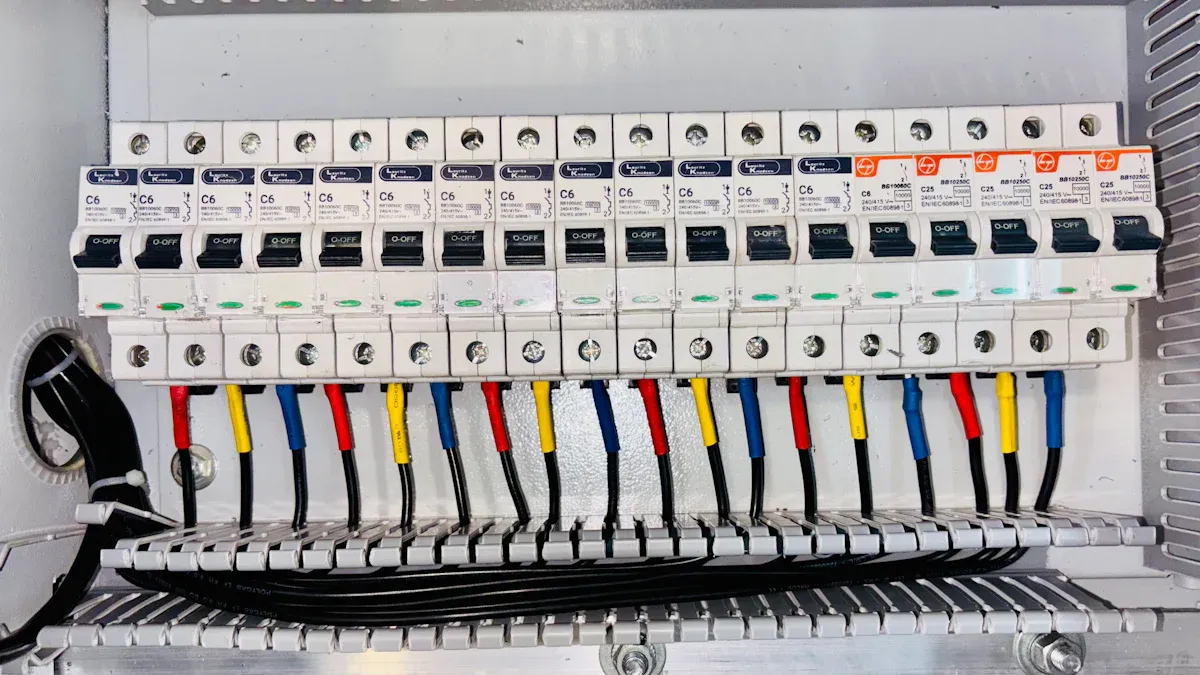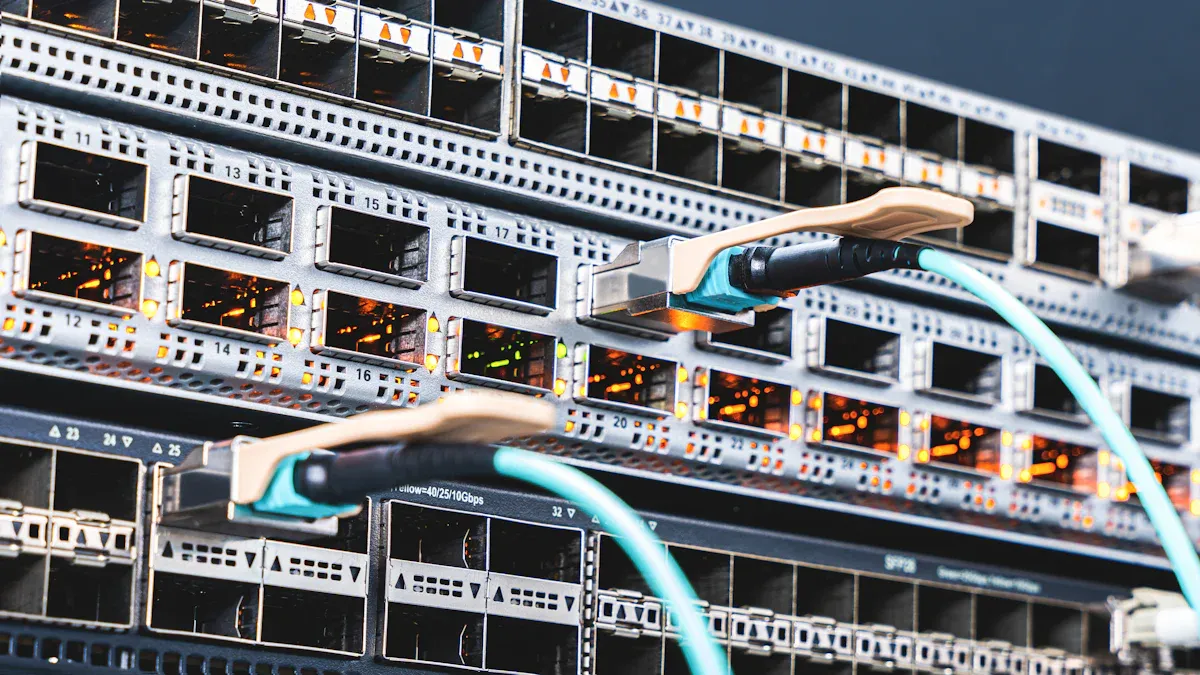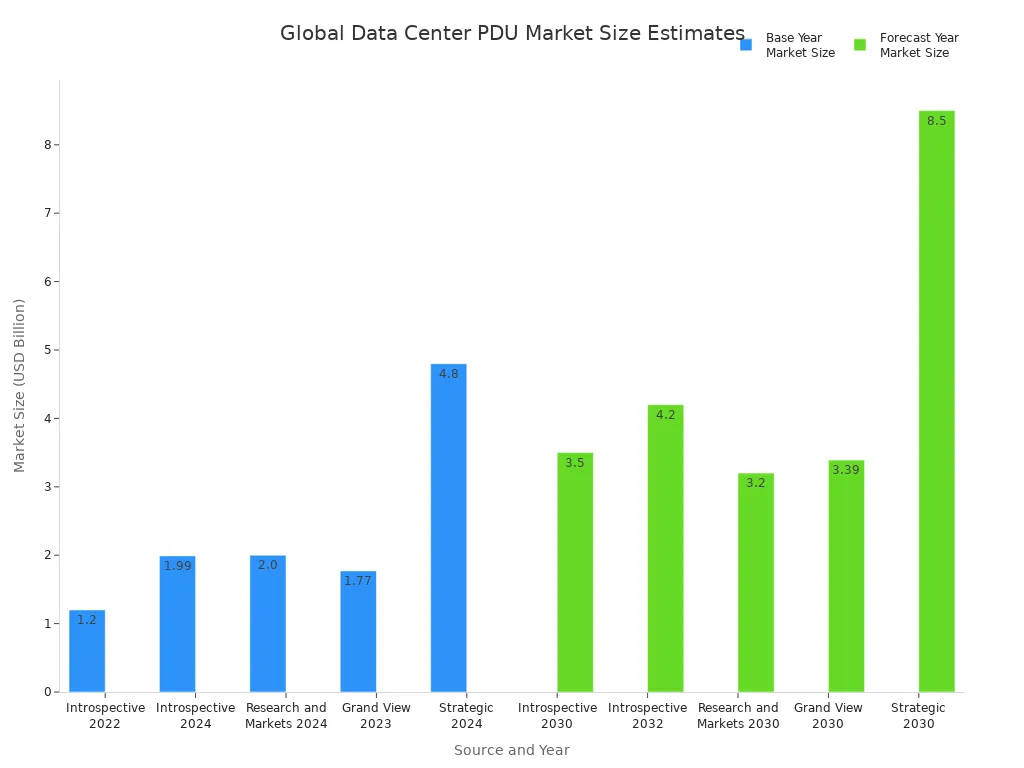
A PDU manages power distribution from a single source to multiple devices, reducing risks of overloads and interruptions in IT environments. Advanced models monitor power quality, detect inefficiencies, and enable remote management. A basic PDU ensures stable delivery, helping prevent outages caused by circuit overloading or voltage disturbances.
Key Takeaways
- A PDU safely distributes power from one source to many devices, helping prevent overloads and outages in IT setups.
- Intelligent PDUs offer remote monitoring, power control, and environmental sensing, improving efficiency and reducing downtime.
- Choosing the right PDU means matching power needs, outlet types, and rack space while considering features like remote access and safety.
Understanding PDU Basics

What Is a PDU?
A Power Distribution Unit (PDU) serves as a central hub for distributing electrical power to multiple devices within IT environments. It connects to an alternating current (AC) or direct current (DC) source, such as utility power, an uninterruptible power supply, or a generator. The PDU then delivers this power to racks of equipment, including servers, storage devices, and networking hardware.
PDUs bridge the gap between primary power sources and IT equipment, ensuring reliable power delivery and reducing cable clutter in server racks.
PDUs come in several types. Basic models act as simple power strips, distributing the correct voltage and current to multiple outlets. Intelligent PDUs offer advanced features such as power monitoring, remote management, and environmental sensors. These enhancements support efficient data center management and help maintain continuous operation by automatically transferring power between multiple inputs when needed.
How a PDU Works
A rack-mounted PDU receives power from an upstream source, such as a floor PDU, utility feed, or backup system like a UPS or generator. It does not generate power but divides the incoming supply into multiple outlets inside the rack or enclosure. This setup allows IT teams to connect various devices, such as servers and switches, to a single power source.
PDUs can be mounted vertically or horizontally, optimizing space and accommodating different rack configurations. Many modern PDUs include monitoring and management capabilities. These features allow administrators to track power consumption, control outlets remotely, and ensure balanced power distribution across all connected devices.
Tip: Proper cable management and regular monitoring help prevent electrical faults and improve airflow within racks.
Main Functions and Components
PDUs perform several essential functions in data centers and server rooms:
- Distribute power to rack-mounted equipment, including servers, switches, and routers.
- Enable power monitoring and control, providing real-time consumption data and analytics.
- Support remote management, allowing administrators to reboot or power cycle devices as needed.
- Ensure continuous operation by switching between power sources when necessary.
A standard PDU contains several key components:
| Component | Function |
|---|---|
| Main Input Breaker | Connects incoming power and energizes the isolation transformer |
| Output Transformer | Provides voltage transformation and isolation |
| Subfeed Breakers | Branch circuit breakers for remote panels or integrated branch circuits |
| Surge Suppression Devices | Protect sensitive electronics from surges and electrical noise |
| Metering Systems | Monitor voltage, current, power, frequency, and load profiling |
| Control Panels | User interfaces for configuration and metering data |
| Communication Modules | Enable remote monitoring and integration with management systems |
Advanced PDUs, often called intelligent PDUs, include additional features such as outlet-level metering, environmental sensors, and integration with Data Center Infrastructure Management (DCIM) software. These capabilities improve operational efficiency, energy optimization, and reliability.
Safety remains a top priority in PDU design. Industry standards such as UL, IEC, and NFPA require input over-current protection, safety interlocks, and emergency shutdown controls. Surge suppression devices and electromagnetic compatibility features protect connected equipment from electrical disturbances.
Note: Regular inspection and maintenance of PDUs help detect wear, prevent hazards, and ensure compliance with safety regulations.
Types, Features, and Choosing the Right PDU

Types of PDUs
Selecting the right PDU starts with understanding the available types. Each type serves different operational needs in IT and data center environments:
- Basic PDUs: Simple power strips that distribute voltage and current without remote capabilities.
- Metered PDUs: Provide real-time power consumption data, supporting load balancing and capacity planning.
- Monitored PDUs: Offer remote monitoring with real-time metrics and alerting.
- Switched PDUs: Enable remote on/off control and power sequencing for enhanced management.
- Switched PDUs with Outlet Metering: Combine all features for maximum control and efficiency.
| PDU Type | Description |
|---|---|
| Basic PDUs | Power strips distributing voltage and current without remote capabilities. |
| Metered Input PDUs | Intelligent PDUs with local and network metering to avoid overloads and calculate efficiency. |
| Metered Outlet PDUs | Meter power locally and over network at outlet level for precise usage and cost allocation. |
| Switched PDUs | Metered outlet features plus remote on/off control and power sequencing. |
Rack-mounted PDUs fit within server racks, saving space and delivering power directly to high-density environments. Floor-mounted PDUs support larger loads and facility-wide distribution, ideal for enterprise data centers.
Key Features and Benefits of PDUs
Modern PDUs offer advanced features that improve efficiency and reliability. Intelligent PDUs provide remote monitoring, real-time breaker status, and accurate power metering. They support outlet-level control, environmental sensing, and web-based management. These features help optimize energy usage, prevent overloads, and reduce downtime.
| Feature | Basic PDUs | Intelligent PDUs |
|---|---|---|
| Power Distribution | Yes | Yes, with optimized design |
| Monitoring and Control | No | Remote monitoring, real-time status, accurate metering |
| Outlet-Level Control | No | Yes, including remote on/off and sequencing |
| Environmental Sensing | No | Yes, with temperature and humidity sensors |
| Remote Access | No | Web-based interfaces and management software |
Metered and switched PDUs enable precise monitoring and remote control, supporting disaster recovery and energy management.

How to Choose the Right PDU
Choosing the right PDU involves several key steps:
- Calculate total power requirements and add a 20-30% buffer for future growth.
- Match outlet and plug types to existing equipment for compatibility.
- Select mounting options (horizontal or vertical) based on rack layout and space.
- Consider advanced features like remote monitoring, environmental sensors, and modularity for scalability.
- Review build quality, certifications, and warranty for long-term reliability.
Tip: Avoid common mistakes such as overloading, ignoring compatibility, and skipping diagnostics after installation. Proper planning ensures uptime, safety, and efficient power management.
PDUs play a vital role in data center reliability and safety. Power distribution failures account for 11% of downtime:
| Cause of Downtime | Percentage |
|---|---|
| Power distribution unit failure | 11% |
Modern PDUs extend equipment life through advanced monitoring and stable power delivery. Intelligent models also lower costs by improving efficiency, reducing downtime, and enabling remote management:
- Energy expenses drop by up to 30%
- Downtime incidents decrease by 30%
- Labor costs fall with remote access
FAQ
What is the difference between a basic PDU and an intelligent PDU?
A basic PDU distributes power only. An intelligent PDU adds monitoring, remote management, and environmental sensors for advanced control and efficiency.
Can a PDU protect equipment from power surges?
Yes. Many PDUs include surge suppression devices. These components shield sensitive equipment from voltage spikes and electrical noise.
How often should IT teams inspect PDUs?
IT teams should inspect PDUs at least every six months. Regular checks help detect wear, prevent hazards, and ensure compliance with safety standards.
Post time: Jul-14-2025

